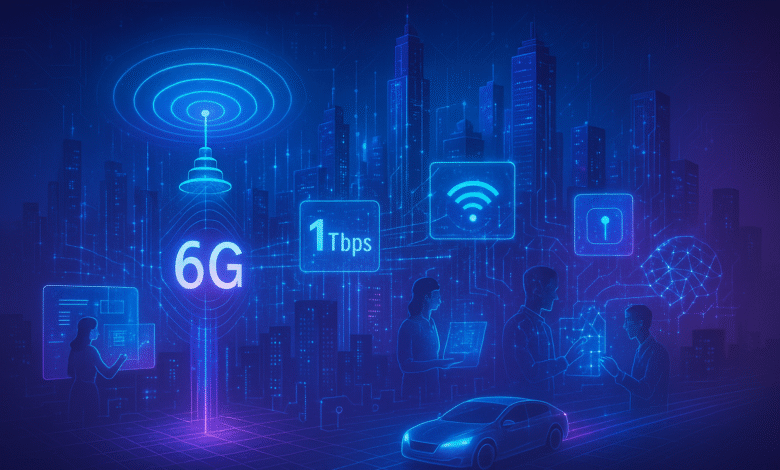How 6G Technology Could Change the Internet Forever
Discover how 6G technology will revolutionize internet connectivity with 100x faster speeds, ultra-low latency, and AI-powered networks by 2030.

While most of the world is still adapting to 5G networks, researchers and tech companies are already looking ahead to the next major leap in wireless communication: 6G technology. This sixth generation wireless standard promises to fundamentally transform how we interact with the internet, offering speeds up to 100 times faster than current 5G networks and latency so low it approaches real-time communication.
The 6G network isn’t just about incremental improvements. It represents a paradigm shift that could merge our physical and digital worlds in ways we’ve never experienced before. From holographic communication to AI-powered networks that can think and adapt autonomously, 6G technology is set to enable applications that sound like science fiction today but will become everyday reality by 2030.
This revolutionary wireless standard will operate on terahertz frequency bands, integrate artificial intelligence natively into network infrastructure, and support unprecedented levels of Internet of Things (IoT) connectivity. As we stand on the brink of this technological transformation, understanding what 6G means for the future of internet connectivity has never been more crucial for businesses, consumers, and society as a whole.
What Is 6G Technology?
6G technology represents the sixth generation of cellular wireless communication networks, designed to succeed the current 5G standard. Unlike previous generations that focused primarily on speed improvements, 6G networks will integrate advanced technologies like artificial intelligence, edge computing, and machine learning directly into the network infrastructure.
The 6G network will operate primarily in the terahertz frequency spectrum, ranging from 95 GHz to 3 THz. This massive expansion of available spectrum will enable data transmission rates that were previously impossible, with theoretical speeds reaching up to 1 terabyte per second in optimal conditions.
Key Technical Specifications
6G technology will deliver several groundbreaking capabilities:
- Ultra-high speeds: Peak data rates of 100 Gbps to 1 Tbps
- Ultra-low latency: Response times as low as 1 microsecond
- Massive connectivity: Support for 10 million devices per square kilometer
- Enhanced reliability: 99.9999% network availability
- Energy efficiency: 100x more energy-efficient than 5G networks
The sixth generation wireless standard will also introduce new concepts like network-as-a-service, where the 6G network can dynamically allocate resources based on real-time demand and artificial intelligence algorithms.
6G vs 5G: A Revolutionary Leap Forward
The comparison between 6G vs 5G reveals the magnitude of advancement this new technology represents. While 5G networks currently offer impressive capabilities, 6G technology will surpass them in virtually every metric.
Speed and Performance Differences
5G networks provide theoretical maximum speeds of up to 20 Gbps, which already represents a significant improvement over 4G LTE. However, 6G networks will deliver speeds 50 to 100 times faster, with potential peak rates of 1 Tbps. To put this in perspective, you could download 142 hours of Netflix’s highest quality video content in just one second using a 6G network.
Latency Improvements
Current 5G networks achieve latency as low as 1 millisecond, enabling real-time applications like autonomous vehicles and remote surgery. 6G technology will reduce this to 1 microsecond, making truly instantaneous communication possible. This ultra-low latency will enable new applications that require split-second responses, such as brain-computer interfaces and real-time holographic interactions.
Frequency and Coverage
While 5G networks operate in both sub-6 GHz and millimeter wave frequencies (24-100 GHz), 6G networks will expand into the terahertz frequency range. This expansion provides access to much wider bandwidth, enabling the massive data rates and advanced applications that define 6G technology.
Intelligence Integration
One of the most significant differences in 6G vs 5G is the native integration of artificial intelligence. While 5G networks can support AI applications, 6G networks will have AI built into their core architecture, enabling self-optimizing, self-healing, and autonomous network operations.
Revolutionary Applications of 6G Networks
6G technology will enable applications that go far beyond faster internet browsing and video streaming. The combination of ultra-low latency, massive bandwidth, and AI-powered networks will create entirely new possibilities for human-computer interaction and digital experiences.
Holographic Communication and Extended Reality
6G networks will make holographic communication a practical reality, allowing people to interact with 3D projections of others in real-time. This technology will revolutionize remote collaboration, education, and entertainment by creating immersive experiences that closely mimic in-person interactions.
Extended reality (XR) applications will benefit enormously from 6G technology. Virtual and augmented reality experiences will become seamless and indistinguishable from reality, with 6G networks providing the bandwidth and ultra-low latency needed for high-resolution, real-time rendering of complex virtual environments.
Internet of Everything (IoE) and Smart Cities
The Internet of Things (IoT) will evolve into the Internet of Everything under 6G networks. With support for 10 million connected devices per square kilometer, 6G technology will enable truly smart cities where every object, surface, and space can be connected and intelligent.
Smart cities powered by 6G networks will feature:
- Autonomous traffic management systems that optimize flow in real-time
- Environmental monitoring networks that track air quality, noise levels, and energy usage
- Smart infrastructure that can predict and prevent failures before they occur
- Connected emergency response systems with instant communication capabilities
Healthcare Revolution
6G technology will transform healthcare through applications like:
- Real-time remote surgery with haptic feedback
- Continuous health monitoring through IoT biosensors
- AI-powered diagnostic systems with instant analysis
- Personalized medicine based on real-time data processing
Autonomous Systems and Robotics
6G networks will enable new levels of automation and robotics. Autonomous vehicles will communicate with each other and infrastructure in real-time, while collaborative robots (cobots) will work alongside humans with unprecedented precision and safety.
AI-Powered 6G Networks: The Intelligence Revolution
The integration of artificial intelligence into 6G networks represents one of the most significant advances in telecommunications history. Unlike previous generations where AI was an external application, 6G technology will have AI embedded natively into the network infrastructure.
Self-Optimizing Networks
AI-powered networks will continuously monitor and optimize their own performance. These 6G networks will automatically adjust bandwidth allocation, routing protocols, and resource distribution based on real-time demand patterns and predictive analytics.
Autonomous Network Management
6G technology will introduce autonomous network management capabilities, where AI algorithms handle routine maintenance, fault detection, and capacity planning without human intervention. This will significantly reduce operational costs and improve network reliability.
Intelligent Edge Computing
6G networks will integrate edge computing with artificial intelligence, bringing computational power closer to end users. This combination will enable real-time processing of massive data volumes, supporting applications like autonomous vehicles and industrial automation that require instant decision-making.
Predictive Capabilities
AI-powered networks will use machine learning algorithms to predict network congestion, equipment failures, and security threats before they occur. This predictive capability will ensure 6G networks maintain optimal performance and security at all times.
Infrastructure and Implementation Challenges
Deploying 6G networks will require significant infrastructure investments and technological breakthroughs. The transition from 5G networks to 6G technology presents several challenges that industry stakeholders must address.
Spectrum Allocation and Regulation
The terahertz frequency bands that 6G networks will utilize require new regulatory frameworks and international coordination. Governments worldwide must allocate spectrum and establish standards that enable global interoperability of 6G technology.
Infrastructure Development
6G networks will build upon existing 5G infrastructure but will require new base stations, antennas, and networking equipment designed for terahertz frequency operation. The shorter range of these high-frequency signals means denser network deployments will be necessary.
Technical Challenges
Several technical hurdles must be overcome for successful 6G technology implementation:
- Signal propagation: Terahertz waves have limited range and are easily blocked by obstacles
- Power consumption: High-frequency operations require more energy-efficient designs
- Device compatibility: New hardware capable of terahertz frequency communication
- Network synchronization: Coordinating millions of connected devices in real-time
Investment Requirements
The global rollout of 6G networks will require unprecedented investment in research, development, and infrastructure. Industry estimates suggest that developing and deploying 6G technology could cost hundreds of billions of dollars worldwide.
Global 6G Development and Competition
The race to develop 6G technology is already underway, with major technology companies, governments, and research institutions investing heavily in sixth generation wireless research and development.
Leading Players and Initiatives
Several countries and organizations are at the forefront of 6G networks development:
- United States: The Next G Alliance, launched by ATIS, focuses on North American 6G technology leadership
- China: Has launched 6G technology test satellites and committed significant government resources
- European Union: The Hexa-X consortium brings together industry and academic leaders
- South Korea: Electronics and Telecommunications Research Institute is researching terahertz frequency applications
- Finland: University of Oulu’s 6Genesis project is developing 6G networks vision for 2030
Industry Collaboration
Major telecommunications equipment manufacturers like Ericsson, Nokia, Huawei, and Samsung are collaborating with research institutions and mobile operators to develop 6G technology standards and implementations.
Standardization Efforts
The 3rd Generation Partnership Project (3GPP) and International Telecommunication Union (ITU) are working to establish global standards for 6G networks, ensuring interoperability and coordinated deployment worldwide.
Security and Privacy in 6G Networks
The advanced capabilities of 6G technology introduce new security challenges that must be addressed to ensure safe and trustworthy sixth generation wireless communications.
Enhanced Security Threats
6G networks will face sophisticated security challenges:
- Expanded attack surface: Millions of connected IoT devices create more potential entry points
- AI vulnerabilities: AI-powered networks may be susceptible to adversarial attacks and model poisoning
- Data privacy: Massive data collection and processing raise privacy concerns
- Supply chain security: Complex 6G technology components increase supply chain risks
Advanced Security Solutions
6G networks will implement cutting-edge security measures:
- Quantum-safe cryptography: Protection against future quantum computing threats
- Zero-trust architecture: Continuous verification of all network participants
- AI-powered threat detection: Real-time identification and response to security incidents
- Blockchain integration: Distributed ledger technology for secure transactions and identity management
Privacy Protection
6G technology will incorporate privacy-by-design principles, ensuring that user data protection is built into the network architecture from the ground up. Advanced encryption and anonymization techniques will protect user privacy while enabling innovative applications.
Environmental Impact and Sustainability
6G networks are being designed with sustainability as a core principle, addressing the environmental challenges posed by increasing digital connectivity and data consumption.
Energy Efficiency Improvements
6G technology will be significantly more energy-efficient than current 5G networks:
- 100x energy efficiency: Advanced semiconductor technology and optimized protocols
- Intelligent power management: AI-driven optimization of network energy consumption
- Green computing: Renewable energy integration and carbon-neutral operations
- Sustainable materials: Environmentally friendly components and manufacturing processes
Reducing Carbon Footprint
6G networks will contribute to global sustainability efforts by:
- Enabling remote work and virtual collaboration, reducing travel needs
- Supporting smart cities with optimized resource management
- Facilitating precision agriculture and environmental monitoring
- Powering autonomous systems that improve energy efficiency
Timeline and Commercial Deployment
The development and deployment of 6G technology follows a carefully planned timeline that aligns with industry standards and technological readiness.
Research and Development Phase (2020-2027)
Current 6G networks research focuses on:
- Fundamental technology development
- Proof-of-concept demonstrations
- Standards definition and specification
- Initial testing and validation
Standardization and Testing (2027-2029)
The pre-commercial phase will include:
- Final standards approval by 3GPP and ITU
- Large-scale testing and optimization
- Equipment manufacturing and certification
- Pilot deployments in select markets
Commercial Launch (2030 and Beyond)
6G technology commercial deployment is expected to begin around 2030, with widespread availability following in subsequent years. Early adopters will likely include:
- Industrial and enterprise applications
- Government and military use cases
- High-value consumer services in major metropolitan areas
- Specialized applications requiring ultra-low latency and high reliability
Economic Impact of 6G Technology
The economic implications of 6G networks extend far beyond the telecommunications industry, with the potential to transform entire sectors of the global economy.
Market Size and Growth Projections
Industry analysts project the 6G technology market could reach hundreds of billions of dollars by the mid-2030s. The economic impact will come from:
- Direct investment in 6G networks infrastructure
- New business models enabled by sixth generation wireless capabilities
- Productivity improvements across all industries
- Innovation in emerging technologies and applications
Industry Transformation
6G technology will drive transformation across multiple sectors:
- Manufacturing: Fully automated factories with real-time optimization
- Transportation: Autonomous vehicle networks and smart logistics
- Healthcare: Personalized medicine and remote care delivery
- Entertainment: Immersive content and virtual experiences
- Education: Remote learning with holographic communication
Job Creation and Skills Development
The 6G networks rollout will create new employment opportunities while requiring workforce development in:
- Network engineering and management
- AI and machine learning applications
- Cybersecurity and privacy protection
- IoT system integration and maintenance
Conclusion
6G technology represents more than just the next iteration of wireless communication – it’s a foundational shift that will reshape how we interact with the digital world. With speeds 100 times faster than current 5G networks, ultra-low latency measured in microseconds, and AI-powered networks that can think and adapt autonomously, 6G networks will enable applications we can barely imagine today. From holographic communication that makes distance irrelevant to smart cities that optimize themselves in real-time, the sixth generation wireless standard will transform industries, create new economic opportunities, and fundamentally change how we live and work. As we approach the 2030 commercial launch timeline, 6G technology stands poised to deliver on its promise of truly connecting the physical and digital worlds, making the impossible possible and forever changing the internet as we know it.











